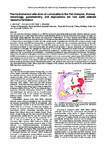The hydrothermal alteration of carbonatite in the Fen Complex, Norway: mineralogy, geochemistry, and implications for rare earth element resource formation
| dc.contributor.author | Marien, C | |
| dc.contributor.author | Guan, Xiaoyi | |
| dc.contributor.author | wilkins, C | |
| dc.date.accessioned | 2017-10-19T13:00:08Z | |
| dc.date.available | 2017-10-19T13:00:08Z | |
| dc.date.issued | 2017-11-14 | |
| dc.identifier.issn | 0026-461X | |
| dc.identifier.issn | 1471-8022 | |
| dc.identifier.uri | http://hdl.handle.net/10026.1/10075 | |
| dc.description.abstract |
ABSTRACTThe Fen Complex in Norway consists of a ~583 Ma composite carbonatite-ijolite-pyroxenite diatreme intrusion. Locally, high grades (up to 1.6 wt.% total REE) of rare-earth elements (REE) are found in a hydrothermally altered, hematite-rich carbonatite known as rødbergite. The progressive transformation of primary igneous carbonatite to rødbergite was studied here using scanning electron microscopy and inductively coupled plasma-mass spectrometry trace-element analysis of 23 bulk samples taken along a key geological transect. A primary mineral assemblage of calcite, dolomite, apatite, pyrite, magnetite and columbite with accessory quartz, baryte, pyrochlore, fluorite and REE fluorocarbonates was found to have transformed progressively into a secondary assemblage of dolomite, Fe-dolomite, baryte, Ba-bearing phlogopite, hematite with accessory apatite, calcite, monazite-(Ce) and quartz. Textural evidence is presented for REE fluorocarbonates and apatite breaking down in igneous carbonatite, and monazite-(Ce) precipitating in rødbergite. The importance of micro-veins, interpreted as feeder fractures, containing secondary monazite and allanite, is highlighted. Textural evidence for included relics of primary apatite-rich carbonatite are also presented. These acted as a trap for monazite-(Ce) precipitation, a mechanism predicted by physical-chemical experiments. The transformation of carbonatite to rødbergite is accompanied by a 10-fold increase in REE concentrations. The highest light REE (LREE) concentrations are found in transitional vein-rich rødbergite, whereas the highest heavy REE (HREE) and Th concentrations are found within the rødbergites, suggesting partial decoupling of LREE and HREE due to the lower stability of HREE complexes in the aqueous hydrothermal fluid. The hydrothermal fluid involved in the formation of rødbergite was oxidizing and had probably interacted with country-rock gneisses. An ore deposit model for the REE-rich rødbergites is presented here which will better inform exploration strategies in the complex, and has implications for carbonatite-hosted REE resources around the world. | |
| dc.format.extent | S115-S131 | |
| dc.language | en | |
| dc.language.iso | en | |
| dc.publisher | Mineralogical Society | |
| dc.subject | rodbergite | |
| dc.subject | ICP-MS | |
| dc.subject | SEM | |
| dc.subject | carbonatite-ijolite-pyroxenite complex | |
| dc.subject | REE mobility | |
| dc.subject | monazite-(Ce) | |
| dc.subject | apatite | |
| dc.subject | thorium | |
| dc.title | The hydrothermal alteration of carbonatite in the Fen Complex, Norway: mineralogy, geochemistry, and implications for rare earth element resource formation | |
| dc.type | journal-article | |
| dc.type | Journal Article | |
| plymouth.author-url | https://www.webofscience.com/api/gateway?GWVersion=2&SrcApp=PARTNER_APP&SrcAuth=LinksAMR&KeyUT=WOS:000435650000006&DestLinkType=FullRecord&DestApp=ALL_WOS&UsrCustomerID=11bb513d99f797142bcfeffcc58ea008 | |
| plymouth.issue | S1 | |
| plymouth.volume | 82 | |
| plymouth.publication-status | Published | |
| plymouth.journal | Mineralogical Magazine | |
| dc.identifier.doi | 10.1180/minmag.2017.081.070 | |
| plymouth.organisational-group | /Plymouth | |
| plymouth.organisational-group | /Plymouth/Faculty of Science and Engineering | |
| plymouth.organisational-group | /Plymouth/REF 2021 Researchers by UoA | |
| plymouth.organisational-group | /Plymouth/REF 2021 Researchers by UoA/UoA07 Earth Systems and Environmental Sciences | |
| dcterms.dateAccepted | 2017-08-09 | |
| dc.identifier.eissn | 1471-8022 | |
| dc.rights.embargoperiod | Not known | |
| rioxxterms.versionofrecord | 10.1180/minmag.2017.081.070 | |
| rioxxterms.licenseref.uri | http://www.rioxx.net/licenses/all-rights-reserved | |
| rioxxterms.licenseref.startdate | 2017-11-14 | |
| rioxxterms.type | Journal Article/Review |


